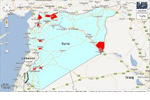
Source: defenceone.com
By: Oubai Shahbandar & Michael Pregent
President Barack Obama rightly has proclaimed that strengthening Syrian opposition forces will form an important component of the wider campaign against the Islamic State. But the Defense Department’s train and equip plan for the Syrian opposition falls far short from balancing the score card against ISIS, or ISIL, and its implementation timeline simply is not fast enough to deny ISIS and al-Qaeda key terrain in Syria.
Why the delay? One answer from U.S. policymakers: Iran.
Source: defenceone.com
By: Oubai Shahbandar & Michael Pregent
President Barack Obama rightly has proclaimed that strengthening Syrian opposition forces will form an important component of the wider campaign against the Islamic State. But the Defense Department’s train and equip plan for the Syrian opposition falls far short from balancing the score card against ISIS, or ISIL, and its implementation timeline simply is not fast enough to deny ISIS and al-Qaeda key terrain in Syria.
Why the delay? One answer from U.S. policymakers: Iran.
Hesitancy to increase U.S. military aid to anti-Assad forces and expand the air campaign in Syria against Iranian backed Assad regime militias seem to be colored by worries that Iran will retaliate, through controlled Shiite extremist militias, against U.S. civilian and military personnel in Iraq. To save Assad, Iran has shown it is ready to tap into its regional proxy terror network to prop up the regime.
The consequences of the American half-measured approach in Syria have been stark: al-Qaeda affiliates this month made startling gains against two of the main moderate Free Syrian Army brigades who spearheaded the initial assault against ISIS in January. Idlib province, long a moderate rebel stronghold, now stands on the verge of falling completely to al-Qaeda. ISIS and al-Qaeda’s goals in Syria are converging, adding impetus to the need to rethink U.S. Central Command’s policy that views Iraq and Syria as two separate areas of operation.
Despite the setbacks, there are still FSA forces, particularly in Aleppo province in the north and pockets of tribal resistance in the east, who albeit are fighting for their existence, that can prosecute the fight against extremists if sufficiently resourced and backed by close air support.
Effectively taking on ISIS requires taking manageable policy and human risks, identifying opportunities and then putting more guns and ammo faster (with requisite oversight) into the hands of moderate Sunni Arabs who are best positioned to reverse ISIS’ momentum while ensuring that anti-Assad forces are plugged into CENTCOM’s targeting process.
As the world’s cameras focus on the Syrian town of Kobane, the site of plucky resistance against a determined ISIS invasion; often overlooked is the Free Syrian Army and Sunni Arab tribal resistance to ISIS in Syria that has yet to factor into U.S. Central Command’s campaign plan.
Compared to the support that the U.S. military has offered to Syrian Kurds battling ISIS, the Free Syrian Army and anti-ISIS Arab tribes have received an undersized amount of aid despite having easily killed off in the past months more ISIS and al-Qaeda fighters than CENTCOM has to date. Indeed, one of the reasons extremists launched this latest campaign against moderateFSA forces was due to an FSA commander killing the emir of Jund al-Aqsa, an al-Qaeda affiliate.
The support that the U.S. military is providing Syria’s Kurds does not have to be mutually exclusive with enhancing coordination and inclusion with the FSA and Syrian Arab tribal forces. Sunni Arab fighters are fighting alongside Syrian Kurds to stave off the ISIS assault in Kobane, and the approval by Kurdistan Regional Government’s President Barzani of deploying Peshmerga forces to Syria is a positive step given the close relationships that exist between Barzani and Sunni Arab tribal leaders on both the Syrian and Iraqi sides of the border.
While Free Syrian Army units faced off against ISIS in the villages of Akhtarin and Marea in the northern Allepo countryside, Assad and Lebanese Hezbollah seized the opportunity in launching a renewed assault to cut off and starve Allepo. Without air cover, the Free Syrian Army forces that began the fight against ISIS in January are rapidly finding themselves out-gunned.
As allied aircraft pound ISIS in Syria, Assad has accelerated his barrel bombing campaign, leading to many erstwhile allies in local communities who have long borne the brunt of bothISIS and Assad, and whom the U.S. and allies hope to recruit into a new training program, to question the intentions of the coalition.
The policy status quo in Washington continues to delink fighting against ISIS with empowering anti-Assad resistance. But this view threatens to repeat the same mistake the United States once made in abandoning the Sunni Arab forces in Iraq. Building local partnerships must entail a commitment to their survival.
The FSA has met all the benchmarks demanded of it by the U.S. They have fought al-Qaeda andISIS as they have fought Assad’s forces and Iran’s. For them, it is an existential struggle against these common foes.
There can be no pressing a ‘pause button’ in Syria. To maintain U.S. credibility and develop effective long term strategic partnerships in Syria, the Pentagon would be wise to open up targeting coordination with FSA commanders, load the C-130s and expedite military aid to theFSA and Sunni tribes accordingly before they are wiped out.
Yes, doing so will be bad for the good Ayatollah in Tehran, and could very well engender attacks against U.S. personnel by Iranian forces or agents. But it will prove a net gain for U.S.and allied Arab interests. And it will save lives.
Oubai Shahbandar is an adviser to the Syrian Opposition Coalition and former Pentagon analyst.
Michael Pregent is an adjunct lecturer at National Defense University and a former U.S. Army intelligence officer.


